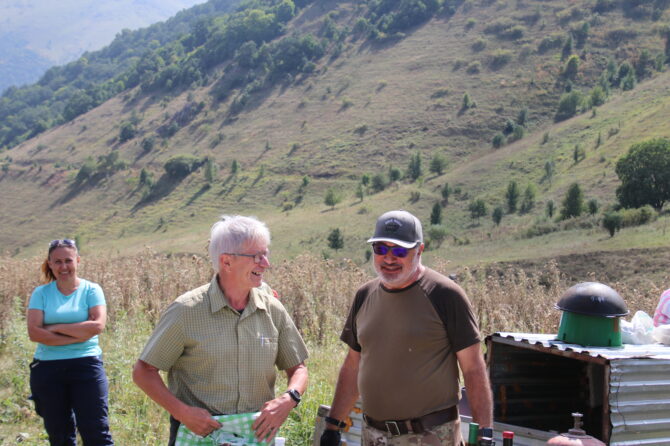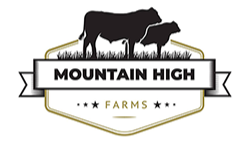
Foreign Press About Us
Georgia and Armenia – Exciting Countries on the Silk Road
By Ursula Freund
This article was published in Beef Cattle Switzerland Magazine, with a circulation of around 6500 copies in German and French
During my late summer vacation, my husband and I had the opportunity to take part in an extraordinarily exciting agricultural tour of the South Caucasus. In this report, I would like to share our experiences through a series of impressions, with a particular focus on Ashot Boghossian’s Angus suckler cow farm.
Over 16 days in Georgia and Armenia, we experienced the people, their culture, landscapes, agriculture, education, and politics.
Our tour group consisted of 16 people, all with agricultural backgrounds or professional expertise in the field. The trip was organized by agronomist Robert Lehmann, a (retired) education professional, in collaboration with local travel agencies and tour guides.
Robert worked closely with the University of Agriculture, Forestry, and Food Science (HAFL) and the Swiss Agency for Development and Cooperation (SDC) on projects aimed at promoting a dual education system in these two countries, modeled after the Swiss approach. Thanks to his excellent connections, we had the opportunity for fascinating encounters and valuable insights.
One highlight of the trip—for me, in particular—was a visit to a suckler cow farm. This visit left a deep impression on our entire group, and I would like to share more details about it.
Ashot Boghossian—a truly charismatic personality
We meet Armenian cattle farmer Ashot Boghossian in Gosh. Our travel group is divided among five off-road jeeps for an adventurous two-hour drive over a rugged, bumpy track that leads us to his Angus suckler herd.
As stated on his website (https://mountainhighfarms.net), his pastures are located in remote areas of the Dilijan National Park, stretching from west to east in northeastern Armenia. These high-altitude grazing lands sit between 1,700 and 2,200 meters above sea level.
While he mentions managing 120 hectares, the land we see appears significantly larger. He leases the land from the government for just two dollars per hectare per year. According to Ashot, millions of hectares of unused land exist in Armenia, offering vast potential for rotational grazing.
Pasture management is a key focus for Ashot, and he speaks passionately about his approach and philosophy, eagerly sharing his insights with us.
Ashot’s grazing system is based on holistic management and mob grazing techniques. He aims to positively influence plant diversity by implementing a rotational grazing system, where the herd moves to fresh pasture almost daily.
His philosophy follows a holistic approach: the animals should spend most of their time on pasture and be fattened exclusively on grass. That’s music to my ears! But for Ashot, “grass” isn’t just grass in a botanical sense.
With pride, he explains that his pastures contain 96 different species of edible grasses, herbs, and medicinal plants, including rare varieties such as thyme, chamomile, rosehip, mint, sorrel, saxifraga, scabious, star jasmine, and lemon balm.
In addition to grazing, his Black Angus cattle also feed on leaves, wild fruits, and berries, such as wild apple, walnut, cornelian cherry, plum, wild pear, gooseberry, medlar, hazelnuts, blackcurrant, hawthorn, and wild strawberry.
At the end of the finishing phase, the cattle are given an acorn diet, which enhances the color, aroma, and flavor of the meat. Ashot firmly believes that this diverse plant-based diet, combined with the absence of concentrated feed, results in natural, high-quality, healthy, tender, and flavorful beef.
Grazing is a passion for him—he believes that cattle belong on pasture. His herd spends around 11 months grazing outdoors, even during winter, when they remain outside 90% of the time. Winters in the region are short, lasting from late February to late March. During this period, he moves the animals to 1,200 meters above sea level, where they have access to a shelter that provides protection from wind and weather. However, even in winter, the cattle primarily graze the surrounding pastures.
Russian Cattle with American Genetics
Ashot’s herd consists of 80 Angus cows, which he imported from Russia in 2019. These animals originally came from Dakota, USA, before being brought to Russia. As a result, his herd carries American genetics, adapted to Russian conditions.
However, Ashot believes that an even better-adapted breed might exist for his specific environment. He is considering Aubrac cattle, a hardy French breed, but it is currently unavailable in Armenia or Russia.
Calving season takes place in April and May.
The three bulls are kept separately from November to July, grazing on pastures during this period. The animals are either sold as breeding stock or, at 22 to 24 months of age, as finished cattle with a live weight of approximately 500 kilograms.
Ashot is also a skilled salesman, as demonstrated by his ability to sell his beef for around $25 per kilogram (slaughter weight) to restaurants, primarily in Yerevan, the capital of Armenia. It is especially important to him that he not only connects with restaurant owners but also speaks directly with the chefs who prepare the meat. Depending on the cut, he recommends cooking methods such as sous vide or slow smoking.
His farm is the only operation in Armenia with 100% Angus cattle and the only suckler cow farm that raises its animals exclusively on grass. Ashot’s business is far from typical.
Interestingly, he did not finance his herd through agriculture. Before starting his farm, he worked as a lawyer alongside his son while raising cattle on the side. His experience with agriculture and cattle began at a young age and was further enriched by time spent in Argentina.
Ashot has acquired most of his knowledge through research and through international exchanges. It is remarkable that he is actively involved in projects aimed at promoting the dual education system in Armenia. His farm will serve as a place where young professionals can gain valuable hands-on experience and benefit from his expertise.
MAVETA Project
During our two-day stay in Armenia, we were accompanied by Dr. Monique Frey, a Swiss agronomist working with the humanitarian organization HEKS, part of the Evangelical Reformed Church. She is involved in the MAVETA project, which focuses on integrating dual agricultural vocational training into Armenia’s legal framework.
The project’s goal is to create a cohesive education policy, strengthen agricultural schools, and establish apprenticeship opportunities within companies. Currently, MAVETA is working with six state agricultural schools across different regions of Armenia.
The selected professions include veterinary specialists, milk and dairy technologists, farmers, agricultural machinery mechanics, dairy farmers, and fruit and nut growers.
The project is being implemented by a local partner in collaboration with HEKS/EPER and the University of Agriculture, Forestry, and Food Sciences (HAFL).
In the photo, Robert Lehmann and Ashot Boghossian at Mountain High Farms, 2024
Leave a reply



Leave a reply